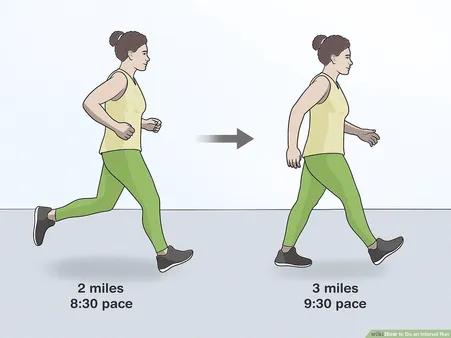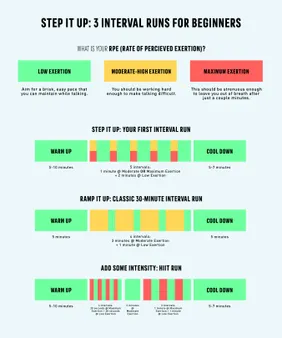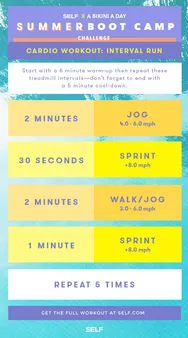Table of Contents
Interval running is a form of high-intensity interval training (HIIT) that involves alternating between short bursts of intense running and brief periods of rest or low-intensity running.
How to do an interval run: Improve Endurance and Speed
I. What is an Interval Run?
What is an Interval Run?
An interval run is a high-intensity training method that involves alternating between periods of high-intensity running and periods of rest or low-intensity running. This type of training is designed to improve your speed, endurance, and overall fitness. Interval runs can be done on a track, treadmill, or even outdoors.
There are many different ways to structure an interval run workout, but the most common method is to alternate between 400-meter repeats and 200-meter recoveries. This means that you would run 400 meters at a fast pace, then jog or walk for 200 meters to recover. You would then repeat this cycle for a total of 8-12 repetitions.
Interval runs can be challenging, but they are also very effective. If you are looking for a way to take your running to the next level, interval training is a great option. Here are some of the benefits of interval running:
- Improved speed and endurance
- Increased calorie burn
- Reduced risk of injury
- Improved mental toughness
- Boosted metabolism
If you are new to interval running, it is important to start slowly and gradually increase the intensity and duration of your workouts over time. You should also listen to your body and take breaks when you need them. With consistency and dedication, you will be able to see the benefits of interval running in no time.
Here are some tips for getting started with interval running:
- Choose a track or treadmill that is safe and well-maintained.
- Warm up with a light jog or walk for 5-10 minutes.
- Start with a short interval workout, such as 4-6 repetitions of 400-meter repeats with 200-meter recoveries.
- Gradually increase the intensity and duration of your workouts over time.
- Listen to your body and take breaks when you need them.
- Stay hydrated by drinking plenty of water before, during, and after your workout.
- Cool down with a light jog or walk for 5-10 minutes.
Interval running is a great way to improve your speed, endurance, and overall fitness. With consistency and dedication, you will be able to see the benefits of interval running in no time.
If you are looking for more information on interval running, check out these related posts:
II. Benefits of Interval Running
Benefits of Interval Running
Interval running is a high-intensity training method that can help you improve your speed, endurance, and overall fitness. Here are some of the benefits of interval running:
- Improved cardiovascular health: Interval running can help to strengthen your heart and lungs, and improve your overall cardiovascular health.
- Increased calorie burn: Interval running can help you burn more calories than traditional steady-state running, which can help you lose weight or maintain a healthy weight.
- Improved speed and endurance: Interval running can help you to improve your speed and endurance, making you a better runner overall.
- Reduced risk of injury: Interval running can help to strengthen your muscles and joints, and reduce your risk of injury.
- Improved mental health: Interval running can help to improve your mood and reduce stress levels.
If you're looking for a way to take your running to the next level, interval running is a great option. Just be sure to start slowly and gradually increase the intensity and duration of your workouts over time.
Here are some tips for getting started with interval running:
- Start with a warm-up: Before you start your interval workout, be sure to warm up with some light jogging or walking for 5-10 minutes.
- Choose your intervals: There are many different ways to structure an interval workout. A common method is to alternate between periods of high-intensity running and periods of rest or low-intensity running.
- Start slowly: When you're first starting out, don't try to do too much too soon. Start with short intervals and gradually increase the duration and intensity of your workouts over time.
- Listen to your body: If you're feeling pain or discomfort, stop running and rest. It's important to listen to your body and avoid pushing yourself too hard.
- Cool down: After your interval workout, be sure to cool down with some light jogging or walking for 5-10 minutes.
Interval running is a great way to improve your running performance and overall fitness. Just be sure to start slowly and gradually increase the intensity and duration of your workouts over time.
Here are some additional tips for getting the most out of your interval running workouts:
- Find a running partner or group: Running with others can help you stay motivated and make your workouts more enjoyable.
- Vary your workouts: Don't do the same interval workout every time. Mix things up to keep your workouts challenging and interesting.
- Set goals: Having a goal in mind can help you stay motivated and focused on your training.
- Be patient: It takes time to see results from interval running. Don't get discouraged if you don't see results immediately. Just keep at it and you will eventually see improvement.
Interval running is a great way to take your running to the next level. Just be sure to start slowly and gradually increase the intensity and duration of your workouts over time. With a little effort, you can see significant improvements in your running performance and overall fitness.
If you're looking for more information on interval running, check out these related posts:
III. How to Do an Interval Run
How to Do an Interval Run
1. Warm Up
Before you start your interval run, it's important to warm up your muscles to prevent injury. A light jog or brisk walk for 5-10 minutes is a good way to get your body ready for the more intense workout to come. The benefits of running include improved cardiovascular health, weight loss, and increased energy levels.
You can also do some dynamic stretches to help improve your range of motion and flexibility. Some good dynamic stretches for runners include leg swings, arm circles, and hip circles. Here are some running exercises and workouts that you can try.
2. Choose Your Intervals
An interval run is a type of workout that alternates between periods of high-intensity running and periods of rest or low-intensity running. The length of the high-intensity intervals and the rest periods can vary depending on your fitness level and goals.
For beginners, a good starting point is to do 30-second intervals of high-intensity running followed by 60 seconds of rest or low-intensity running. You can gradually increase the length of the high-intensity intervals and decrease the length of the rest periods as you get more fit.
Interval Type | Duration |
|---|---|
Warm-up | 5-10 minutes |
High-intensity interval | 30 seconds |
Rest or low-intensity interval | 60 seconds |
Cool-down | 5-10 minutes |
3. Start Running
Once you've chosen your intervals, it's time to start running. During the high-intensity intervals, push yourself to run as fast as you can. During the rest or low-intensity intervals, slow down to a pace that allows you to recover. You can listen to running music and playlists while running to keep yourself motivated.
It's important to listen to your body and take breaks when you need them. If you start to feel pain, stop running and rest. Don't try to push yourself too hard, especially when you're first starting out.
4. Cool Down
After you've finished your interval run, it's important to cool down to help your body recover. A light jog or brisk walk for 5-10 minutes is a good way to cool down. You can also do some static stretches to help improve your flexibility.
Interval running can be a great way to improve your cardiovascular health, burn calories, and build endurance. If you're new to interval running, start slowly and gradually increase the intensity and duration of your workouts as you get more fit.
Interval Running Workouts
Here are a few sample interval running workouts that you can try:
Beginner Interval Workout
- Warm up with a 5-10 minute light jog or brisk walk.
- Run at a high intensity for 30 seconds.
- Rest or jog slowly for 60 seconds.
- Repeat steps 2 and 3 for a total of 8-10 intervals.
- Cool down with a 5-10 minute light jog or brisk walk.
Intermediate Interval Workout
- Warm up with a 5-10 minute light jog or brisk walk.
- Run at a high intensity for 45 seconds.
- Rest or jog slowly for 75 seconds.
- Repeat steps 2 and 3 for a total of 6-8 intervals.
- Cool down with a 5-10 minute light jog or brisk walk.
Advanced Interval Workout
- Warm up with a 5-10 minute light jog or brisk walk.
- Run at a high intensity for 60 seconds.
- Rest or jog slowly for 90 seconds.
- Repeat steps 2 and 3 for a total of 4-6 intervals.
- Cool down with a 5-10 minute light jog or brisk walk.
These are just a few examples of interval running workouts. You can adjust the intensity, duration, and number of intervals to fit your own fitness level and goals. With consistency, you will enjoy the benefits of running which is improved cardiovascular health, weight loss, and increased energy levels.
IV. Interval Run Workouts
Interval Run Workouts
Interval running workouts are a great way to improve your speed, endurance, and overall fitness. Here are a few sample workouts to get you started:
- Beginner Interval Workout:
- Warm up with a 5-minute jog.
- Run at a moderate pace for 1 minute.
- Sprint for 30 seconds.
- Repeat steps 2 and 3 for 8-10 rounds.
- Cool down with a 5-minute jog.
Intermediate Interval Workout:
- Warm up with a 5-minute jog.
- Run at a moderate pace for 2 minutes.
- Sprint for 45 seconds.
- Repeat steps 2 and 3 for 6-8 rounds.
- Cool down with a 5-minute jog.
Advanced Interval Workout:
- Warm up with a 5-minute jog.
- Run at a moderate pace for 3 minutes.
- Sprint for 1 minute.
- Repeat steps 2 and 3 for 4-6 rounds.
- Cool down with a 5-minute jog.
These are just a few examples of interval running workouts. You can adjust the duration and intensity of the intervals to fit your own fitness level and goals. Be sure to listen to your body and take breaks when you need them.
Here are some tips for getting the most out of your interval running workouts:
- Make sure you warm up properly before starting your workout.
- Start with a slow pace and gradually increase your speed as you get more comfortable.
- Don't be afraid to take breaks when you need them.
- Stay hydrated by drinking plenty of water before, during, and after your workout.
- Listen to your body and stop if you feel pain.
Interval running is a challenging but rewarding workout that can help you improve your overall fitness. By following these tips, you can get the most out of your interval running workouts and reach your fitness goals.
If you're new to interval running, it's a good idea to start with a beginner workout and gradually increase the intensity and duration of your workouts as you get more fit. You can also find many interval running workouts online or in fitness magazines.
No matter what your fitness level, interval running is a great way to improve your speed, endurance, and overall fitness. So what are you waiting for? Give it a try today!
Here are some additional tips for interval running:
- Find a running partner or group to help you stay motivated.
- Choose a route that is safe and well-lit.
- Wear comfortable clothing and shoes.
- Be aware of your surroundings and stay safe.
With a little planning and preparation, you can make interval running a safe and enjoyable part of your fitness routine.
So what are you waiting for? Get out there and start running!
V. Conclusion
Interval running is a highly effective training method that can improve your running performance and overall fitness. By alternating between periods of high-intensity running and rest or low-intensity running, you can push your body to new limits and achieve faster speeds, increased endurance, and better overall health. Whether you're a beginner or an experienced runner, incorporating interval running into your training plan can help you reach your running goals and take your performance to the next level.